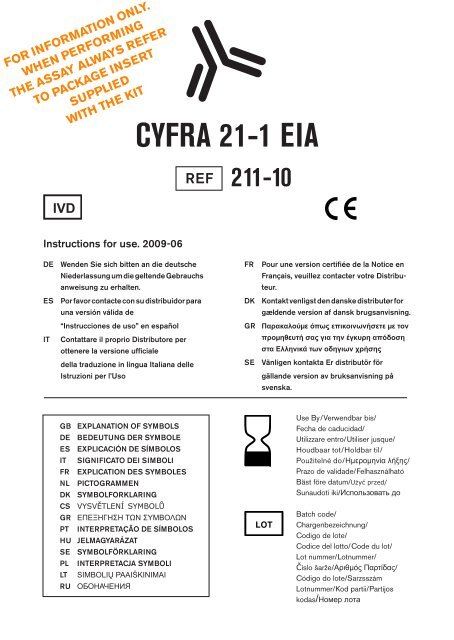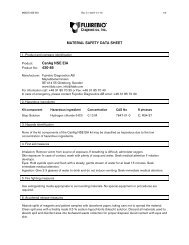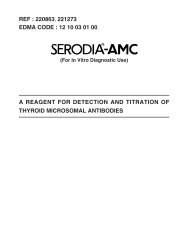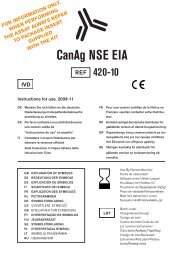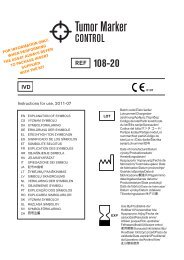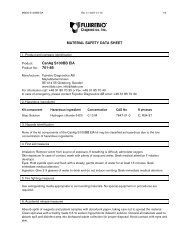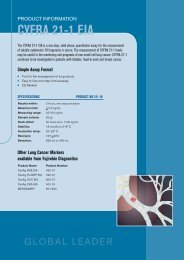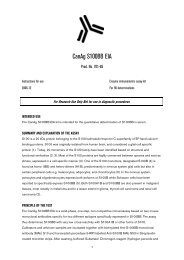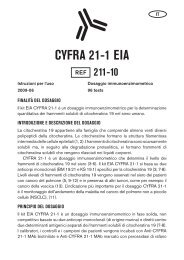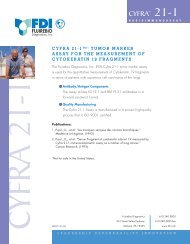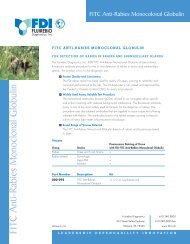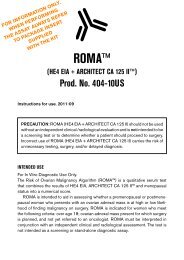CYFRA 21-1 EIA 211-10 2009-06 F5963 r0 (3).pdf - Fujirebio ...
CYFRA 21-1 EIA 211-10 2009-06 F5963 r0 (3).pdf - Fujirebio ...
CYFRA 21-1 EIA 211-10 2009-06 F5963 r0 (3).pdf - Fujirebio ...
Create successful ePaper yourself
Turn your PDF publications into a flip-book with our unique Google optimized e-Paper software.
REAGENTS• Each <strong>CYFRA</strong> <strong>21</strong>-1 <strong>EIA</strong> kit contains reagents for 96 tests.• The expiry date of the kit is stated on the label on the outside of the kit box.• Do not use the kit beyond the expiry date.• Do not mix reagents from different kit lots.• Store the kit at 2–8°C. Do not freeze.• Opened reagents are stable according to the table below provided they arenot contaminated, stored in resealed original containers and handled asprescribed. Return to 2-8°C immediately after use.Component Quantity Storage and stabilityafter first useMICROPLAStreptavidin Microplate 1 Plate 2—8°C until expirydate stated on the plate12 x 8 breakable wells coated with streptavidin. After opening, immediately returnunused strips to the aluminum pouch, containing desiccant. Reseal carefully tokeep dry.CAL <strong>CYFRA</strong> <strong>21</strong>-1 A<strong>CYFRA</strong> <strong>21</strong>-1 Calibrator A 1 x 8 mL 2–8°C until expirydate stated on the vialPhosphate buffered salt solution containing bovine serum albumin, an inert yellowdye, and a non-azide antimicrobial preservative. Ready for use. Should also be usedfor dilution of samples.5
Component Quantity Storage and stabilityafter first useBIOTINAnti-<strong>CYFRA</strong> <strong>21</strong>-1Biotin Anti-<strong>CYFRA</strong> <strong>21</strong>-1 1 x 15 mL 2—8°C until expirydate stated on the vialBiotin Anti-<strong>CYFRA</strong> <strong>21</strong>-1 monoclonal antibody from mouse, approximately 1.25 µg/mL. Contains Tris-HCl buffered salt solution (pH 7.2), bovine serum albumin, blockingagents, detergent, an inert blue dye, and a non-azide antimicrobial preservative. Tobe mixed with Tracer before use.CONJAnti-<strong>CYFRA</strong> <strong>21</strong>-1Tracer, HRP Anti-<strong>CYFRA</strong> <strong>21</strong>-11 x 0.75 mL 2—8°C until expirydate stated on the vialStock Solution of HRP Anti-<strong>CYFRA</strong> <strong>21</strong>-1 monoclonal antibody from mouse,approximately 42 μg/mL. Contains non-azide antimicrobial preservatives. To bemixed with Biotin Anti-<strong>CYFRA</strong> <strong>21</strong>-1 prior to use.SUBSTMBTMB HRP-Substrate 1 x 12 mL 2—8°C until expirydate stated on the vialContains buffered hydrogen peroxide and 3, 3’, 5, 5’ tetra-methylbenzidine (TMB).Ready for use.STOPStop Solution 1 x 15 mL 2—8°C until expirydate stated on the vialContains 0.12 M hydrochloric acid. Ready for use.7
SPECIMEN COLLECTION AND HANDLINGThe <strong>CYFRA</strong> <strong>21</strong>-1 <strong>EIA</strong> is intended for use with serum. Collect blood by venipunctureand separate the serum according to common procedures. Samples can be storedat 2-8°C for 1 day. For longer periods store samples at -40°C or below. Avoidrepeated freezing and thawing of the samples. If aliquoted choose the right sizedtube i.e. limit the empty space in the tube. Bring frozen samples to room temperatureand mix gently before analysis.Note: Mixing of samples using roller mixers must be limited to a maximum of 1 minutewith a maximum speed of 16 rpm. Mixing of samples using electric vibration mixers(Vortex) must be limited to a maximum of 5 seconds. Samples that contain grossparticulates should be centrifuged at <strong>10</strong>.000 x g for <strong>10</strong> minutes prior to use toeliminate any particulate matter that may have developed from the thawing process.PROCEDUREMaterials required but not supplied with the kit1. Microplate shakerShaking should be medium to vigorous, approximately 900-1<strong>10</strong>0 oscillations/min.2. Microplate wash deviceAutomatic plate wash capable of performing 1 and 6 washing cycles with aminimal fill volume of 350 µL/well/washcycle.The Nunc Immuno-8 manual strip washer is recommended if an automaticmicroplate washer is not used.3. Microplate spectrophotometerWith a wavelength of 620 nm and/or 405 nm, and an absorbance range of0 to 3.0.4. Precision pipettesWith disposable plastic tips for dispensing microliter volumes. An 8-channelpipette or dispenser pipette with disposable plastic tips for delivery of <strong>10</strong>0 µLis recommended but not required. Pipettes for dispensing milliliter volumes.5. Distilled or deionised waterFor reconstitution of <strong>CYFRA</strong> <strong>21</strong>-1 Calibrators, <strong>CYFRA</strong> <strong>21</strong>-1 Controls and forpreparation of diluted wash solution.9
Calculation of results with diluted samplesSamples with <strong>CYFRA</strong> <strong>21</strong>-1 concentrations above the measuring range can be dilutedwith <strong>CYFRA</strong> <strong>21</strong>-1 Calibrator A. The recommended dilution is 1/2.- 1/2 dilution = <strong>10</strong>0 μL of specimen + <strong>10</strong>0 μL of <strong>CYFRA</strong> <strong>21</strong>-1 Calibrator AThe <strong>CYFRA</strong> <strong>21</strong>-1 concentration of the diluted sample is then calculated as:- Dilution 1/2 : 2 x measured valueLIMITATIONS OF THE PROCEDUREPatients with confirmed cancer may have <strong>CYFRA</strong> <strong>21</strong>-1 values in the same range ashealthy subjects. Elevated levels of <strong>CYFRA</strong> <strong>21</strong>-1 may also be found in subjects withnon-malignant disease e.g. acute pneumonia, tuberculosis, liver diseases and renalfailure. Therefore, the level of <strong>CYFRA</strong> <strong>21</strong>-1 cannot be used as absolute evidencefor the presence or absence of malignant disease and the <strong>CYFRA</strong> <strong>21</strong>-1 <strong>EIA</strong> shouldnot be used in cancer screening. The results of the test should be interpreted onlyin conjunction with other investigations and procedures in the diagnosis of diseaseand the <strong>CYFRA</strong> <strong>21</strong>-1 test should not replace any established clinical examination.Contamination of the sample with saliva may cause falsely evated levels of <strong>CYFRA</strong><strong>21</strong>-1. Anti-reagent antibodies (human anti-mouse antibody (HAMA) or heterophilicantibodies) in the patient sample may occasionally interfere with the assay, eventhough specific blocking agents are included in the buffer. Excessive mixing mayresult in artifactually decreased <strong>CYFRA</strong> <strong>21</strong>-1 values, therefore mixing of samplesusing roller mixers must be limited to a maximum of 1 minute with a maximumspeed of 16 rpm. Mixing of samples using electric vibration mixers (Vortex) mustbe limited to a maximum of 5 seconds. If aliquoted choose the right sized tubei.e. limit the empty space in the tube.EXPECTED VALUESThe level of <strong>CYFRA</strong> <strong>21</strong>-1 was determined in 497 blood donors. The mean valuewas 0.7 ng/mL and the median value was 0.6 ng/mL.95% of the blood donors had <strong>CYFRA</strong> values below 1.6 ng/mL.It is recommended that each laboratory establish its own reference value for thepopulation of interest.PERFORMANCE CHARACTERISTICSPrecisionTotal precision was determined according to NCCLS guideline EP5-A2 (16)using four levels of frozen pooled human serum containing added <strong>CYFRA</strong> <strong>21</strong>-1.Each sample was randomly pipetted in duplicates and analysed twice each dayover 20 days i.e. 40 runs with 40 different templates by three different techniciansusing 2 different <strong>CYFRA</strong> <strong>21</strong>-1 <strong>EIA</strong> kit batches.18
Dilution LinearityThe <strong>CYFRA</strong> <strong>21</strong>-1<strong>EIA</strong> assay mean dilution linearity is <strong>10</strong>0 ± 20%.A study was conducted for the <strong>CYFRA</strong> <strong>21</strong>-1 <strong>EIA</strong> modeled after the NCCLS(CLSI) guideline EP6-A (18). Serum samples with elevated <strong>CYFRA</strong> <strong>21</strong>-1 valueswere diluted with <strong>CYFRA</strong> <strong>21</strong>-1 Calibrator A (zero). The <strong>CYFRA</strong> <strong>21</strong>-1 concentrationwas determined for each dilution and the percent (%) recovery was calculated.Representative data from this study is summarized in the following table*:Sample Final Dilution Obtained Expected PercentFactor Value (ng/mL) Value (ng/mL) Recovery** (%)A Undiluted 43.9 43.9 <strong>10</strong>01:1.25 34.8 35.1 991:1.7 26.0 26.3 991:2 <strong>21</strong>.5 <strong>21</strong>.9 981:2.5 17.1 17.5 971:5 9.0 8.8 <strong>10</strong><strong>21</strong>:<strong>10</strong> 4.3 4.4 991:20 2.2 2.2 <strong>10</strong>2B Undiluted 36.9 36.9 <strong>10</strong>01:1.25 28.6 29.5 971:1.7 <strong>21</strong>.1 22.1 961:2 18.3 18.4 991:2.5 14.5 14.8 981:5 6.9 7.4 931:<strong>10</strong> 3.2 3.7 861:20 1.5 1.8 81C Undiluted 43.2 43.2 <strong>10</strong>01:1.25 34.1 34.6 991:1.7 25.4 25.9 981:2 <strong>21</strong>.0 <strong>21</strong>.6 971:2.5 16.5 17.3 961:5 7.8 8.6 911:<strong>10</strong> 3.8 4.3 871:20 1.8 2.2 83<strong>21</strong>
Sample Final Dilution Obtained Expected PercentFactor Value (ng/mL) Value (ng/mL) Recovery** (%)D Undiluted 43.7 43.7 <strong>10</strong>01:1.25 33.1 35.0 951:1.7 25.9 26.2 991:2 <strong>21</strong>.4 <strong>21</strong>.9 981:2.5 16.6 17.5 951:5 7.9 8.7 901:<strong>10</strong> 3.8 4.4 861:20 1.8 2.2 80E Undiluted 39.6 39.6 <strong>10</strong>01:1.25 30.6 31.7 971:1.7 23.6 23.8 991:2 19.7 19.8 <strong>10</strong>01:2.5 15.2 15.8 961:5 7.3 7.9 9<strong>21</strong>:<strong>10</strong> 3.5 4.0 881:20 1.6 2.0 82Average recovery across the five diluted samples shown above was found to be94%.*Representative data; results in individual laboratories may vary from these data.**% Recovery= <strong>CYFRA</strong> <strong>21</strong>-1 Concentration obtained x Dilution factor/Undiluted<strong>CYFRA</strong> <strong>21</strong>-1 Concentration.22
Analytical SpecificityThe <strong>CYFRA</strong> <strong>21</strong>-1 <strong>EIA</strong> assay mean assay specificity is <strong>10</strong>0 ± 15%.Recovery studies were performed to compare sera containing the followingcompounds at the indicated concentrations with control sera. The NCCLSguideline EP7-A (19) was used to design the interference experiments. Thefollowing substances and concentrations were tested and found not to interferewith the test.Endogenous serum interferencesTest ConcentrationTriglyceridesBillirubinHemoglobinTotal ProteinChemotherapeutic drug interferencesCarboplatinCisplatinDexamethasoneDoxorubicinLeucovorinMethotrexatePaclitaxel30 mg/mL0.2 mg/mL5 mg/mL120 mg/mLTest Concentration500 µg/mL165 µg/mL<strong>10</strong> µg/mL1.16 µg/mL2.68 µg/mL45 µg/mL3.5 ng/mLPotentially interfering clinical conditionsThe <strong>CYFRA</strong> <strong>21</strong>-1 <strong>EIA</strong> assay was evaluated using specimens with HAMA andRheumatoid Factor (RF) to further assess the assay specificity. Six specimenspositive for HAMA and five specimens positive for RF were evaluated for %recovery with <strong>CYFRA</strong> <strong>21</strong>-1 antigen spiked into each specimen at approximately 5and 25 ng/mL. Mean recovery results are summarized in the following table.*Clinical condition Number of specimens Mean % recoveryHAMA 6 98RF 5 <strong>10</strong>1*Representative data; results in individual laboratories may vary from these data.23
WARRANTYAny change or modification of the procedure not recommended by <strong>Fujirebio</strong>Diagnostics may affect the results, in which event <strong>Fujirebio</strong> Diagnostics disclaimsall warranties expressed, implied or statutory including the implied warranty ofmerchantability and fitness for use.24
REFERENCES1. Moll R, Franke WW, Schiller DL, Geiger B, Krepler R. The catalog of humancytokeratins: patterns of expression of specific cytokeratins in normal epithelia,tumors and cultured cells. Cell 1982;31:11-242. Hesse M, Magin TM, Weber K. Genes for intermediate filament proteins andthe draft sequence of the human genome: Novel Keratin genes and a surprisinglyhigh number of pseudogenes related to keratin genes 8 and 18. J Cell Sci2001;114:2569-25753. Bodenmüller H, Ofenloch-Hähnle B, Lane EB, Dessauer A, Böttger V, DoniéF. Lung Cancer associated Keratin 19 fragments: Development and BiochemicalCharacterization of the new Serum Assay Enzymun-Test <strong>CYFRA</strong> <strong>21</strong>-1.Int J Biol Markers 1994;9:75-814. Bodenmüller H. The Biochemistry of <strong>CYFRA</strong> <strong>21</strong>-1 and other cytokeratin-tests.Scand J Clin Lab Invest Suppl 1995;;2<strong>21</strong>:60-665. Stieber P, Dienemann H, Hasholzner U, Müller C, Poley S, Hofmann K,Fateh-Moghadam. Comparison of Cytokeratin Fragment 19 (<strong>CYFRA</strong> <strong>21</strong>-1)Tissue Polypeptide antigen (TPA) and Tissue Polypeptide Specific Antigen (TPS)as Tumor Markers in Lung Cancer. Eur J Clin Chem Clin Biochem1993;31:689-6946. Bodenmüller H, Donié F, Kaufmann M, Banauch D, The tumor markers TPA,TPS, TPAcyk and <strong>CYFRA</strong> <strong>21</strong>-1 react differently with the keratins 8, 18 and19. Int J Biol Markers 1994;9:70-74.7. Böttger V, Stasiak PC, Harrison DL, Mellerick DM, Lane EB. Epitope mappingof monoclonal antibodies to keratin 19 using keratin fragments, syntheticpeptides and phage peptide libraries. Eur J Biochem 1995;231(2):475-85.8. Stigbrand T et al. Epitope specificity of 30 monoclonal antibodies againstcytokeratin antigens: the ISOBM TD5-1 Workshop. Tumor Biol 1998;19(2):132-52.9. Stieber P, Hasholzner U, Bodenmüller H, Nagel D, Sunder-Plassmann L,Dienemann H, Meier W, Fateh-Moghadam A. <strong>CYFRA</strong> <strong>21</strong>-1. A new marker inlung cancer. Cancer 1993;72(3):707-13.<strong>10</strong>. Ebert W, Dienemann H, Fateh-Moghadam A, Scheulen M, Konietzko N,Schleich T, Bombardieri E. Cytokeratin 19 fragment <strong>CYFRA</strong> <strong>21</strong>-1 comparedwith carcinoembryonic antigen, squamous cell carcinoma antigen and neuronspecificenolase in lung cancer. Results of an international multicentre study.Eur J Clin Chem Clin Biochem 1994;32(3):189-99.11. Stieber P, Zimmermann A, Reinmiedl J, Müller C, Hoffmann H, DienemannH. <strong>CYFRA</strong> <strong>21</strong>-1 in the early diagnosis of recurrent disease in non small celllung carcinomas (NSCLC). Anticancer Res 1999;19(4A): 2665-8.25
12. Pujol JL, Molinier O, Ebert W, Daurès JP, Barlesi F, Buccheri G, Paesmans M,Quoix E, Moro-Sibilot D, Szturmowicz M, Bréchot JM, Muley T, Grenier J.<strong>CYFRA</strong> <strong>21</strong>-1 is a prognostic determinant in non-small-cell lung cancer: resultsof a meta-analysis in 2<strong>06</strong>3 patients. Br J Cancer 2004;90(11):2097-<strong>10</strong>5.13. Stieber P, Dienemann H, Hasholzner U, Fabricius PG, Schambeck C, WeinzierlM, Poley S, Samtleben W, Hofmann K, Meier W, et al. Comparison of <strong>CYFRA</strong><strong>21</strong>-1, TPA and TPS in lung cancer, urinary bladder cancer and benign diseases.Int J Biol Markers 1994;9(2):82-8.14. US Department of Labor, Occuptional Safety and Health Administration, 29CFR Part 19<strong>10</strong>.<strong>10</strong>30, Occupational Exposure to Blood Borne Pathogens.15. US Department of Health and Human Services: Biosafety in Microbiologicaland Biomedical Laboratories: 4th Edition Washington DC: US GovernmentPrinting Office May, 1999.16. National Committee for Clinical Laboratory Standards (NCCLS/CLSI), Evaluationof Precision Performance of Clinical Chemistry Devices; Approved Guideline– Second Edition. EP5-A2 (2004).17. National Committee for Clinical Laboratory Standards (NCCLS/CLSI), Protocolsfor Determination of Limits of Detection and Limits of Quantitation; ApprovedGuideline. EP17-A (2004).18. National Committee for Clinical Laboratory Standards (NCCLS/CLSI), Evaluationof the Linearity of Quantitative Measurement Procedures: A Statistical Approach;Approved Guideline. EP6-A.19. National Committee for Clinical Laboratory Standards (NCCLS/CLSI), InterferenceTesting in Clinical Chemistry, Approved Guideline, EP7-A.26
CanAg ® is a registered trademark of <strong>Fujirebio</strong> Diagnostics AB<strong>Fujirebio</strong> Diagnostics ABElof Lindälvs gata 13PO Box 1<strong>21</strong> 32SE-402 42 GöteborgSwedenPhone + 46 31 85 70 30Fax + 46 31 85 70 40info@fdab.comwww.fdab.com28<strong>CYFRA</strong> <strong>21</strong>-1 <strong>EIA</strong> Prod. No. <strong>21</strong>1-<strong>10</strong>, <strong>2009</strong>-<strong>06</strong>. <strong>F5963</strong>, <strong>r0</strong>


